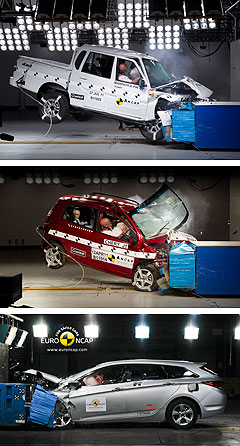Two ANCAP stars for Chery J11
BY HAITHAM RAZAGUI | 6th Oct 2011

The J11 gets the questionable honour of being the only passenger car currently on sale to achieve less than three stars and joins the two-star hall of shame also occupied by the Chinese Great Wall V240 and Indian Mahindra Pik-Up utes – although it performed better than the one-star Proton Jumbuk ute and Mitsubishi Express van.
Due to all J11s in Australia being recalled last month to fit safety-enhancing replacement front-seat backrests – as was carried out for the J1 in August in response to its three-star rating – ANCAP delayed the side-impact test.
However, the J11’s poor score of just 2 out of 16 for occupant safety in the fontal offset crash test – which involves slamming the car into a deformable barrier at 64km/h – meant that even with full points awarded for side impact, it was impossible for the car to qualify for more than two stars.
ANCAP chair Lauchlan McIntosh said the organisation acted “in the interests of consumers” by publishing the J11’s test results before the side impact test had been carried out, but that the test will go ahead “following completion of the recall campaign”.
“Under ANCAP’s rating system, the poor result in the frontal offset test restricts the Chery J11 to a maximum 2-star rating – irrespective of the outcome of the side impact test,” he said.

“The passenger compartment lost structural integrity and there was excessive pedal displacement. Protection from serious chest, leg and foot injury was poor for the driver.” In testing, the J11’s brake pedal moved rearwards 138mm and the clutch pedal moved upwards 103mm. The steering wheel hub moved 138mm rearwards, 58mm upwards and 11mm sideways, but the airbag “cushioned the head of the driver and contact was stable”.
Dashboard components were hazardous for both driver and passenger, with the steering column a threat to the driver and console components a risk for the passenger.
The A pillar also moved 133mm rearwards and ANCAP said the gap that opened up between the window frame and door frame “posed a risk of partial ejection for the driver”. Tools were required to open the driver’s door.
The J11 also scored a damning zero out of a possible 36 points for pedestrian protection, with poor performance in all aspects of the test. ANCAP said Chery could make “many improvements” to the J11 that would “result in better performance”.
Ateco Automotive Chinese brands spokesman Daniel Cotterill said the company was “surprised and disappointed” with the J11’s crash test result, but added that “it is worth pointing out that it does still fully comply with all requirements of the Australian Design Rules”.
He said a Chery engineer observed the crash tests “in keeping with our policy”, and that work – separate to the recall – “is already underway in China to improve the J11”.
Although Mr Cotterill could not say what the work in China involved, he understood that “additional airbags will be incorporated into the design”.
However, with only 807 of the 1664 J11s imported into Australia having been registered to date, the Sydney-based agent must still sell the remaining 857 before new and improved stock starts to arrive.
While history has shown that extra airbags do not necessarily translate into a better ANCAP rating, Mr Cotterill said Ateco expected it would be a different story with the J11.
The Mahindra Pik-up – which originally scored two stars in 2008 – retained its original two-star rating after a re-test last month despite the addition of airbags, seatbelt pretensioners and anti-lock brakes.
“Our policy to date has been to not only enhance the cars being manufactured but also to go back and improve the cars that are in the field as well,” said Mr Cotterill.
“Part of the reason we have the policy of wherever possible getting the crash test engineers out is that it allows them to see first hand what the standards are in this country and how the tests are conducted.
“It cuts out any lag between the testing and the results and the most important thing is they get to see the results for themselves.
“I can tell you that the upshot of this series of tests has been that we certainly have Chery’s attention at the highest level.
“We’ve recently had senior executives from Chery Australia meet with the president of Chery and they left in no doubt that Chery’s got a pretty serious commitment to improve their products.” Chery’s latest addition to its Australian line-up, the small-segment J3 hatch that went on sale last month from $14,990 drive-away, comes standard with six airbags but has not yet been formally crash-tested.
Meanwhile, ANCAP awarded Hyundai’s new mid-size i40 wagon – which will be launched in Australia next week – a maximum five-star rating based on its Euro NCAP result of 34.18 out of 37 based on a left-hand-drive European-spec diesel model.
The i40 scored 14.18 in the frontal offset crash, 16 out of 16 in the side impact test and scored a bonus two points in the pole test. It was awarded a “marginal” 15.53 out of 36 for pedestrian protection.
Its brake pedal moved 64mm rearwards and 14mm upwards, the steering wheel hub moved 34mm forwards, 37mm downward and 5mm sideways, and the A-pillar moved 11mm rearwards, with all doors remaining closed during the crash and easily openable afterwards.
Steering column components were found to be a potential injury source for the driver’s knees.